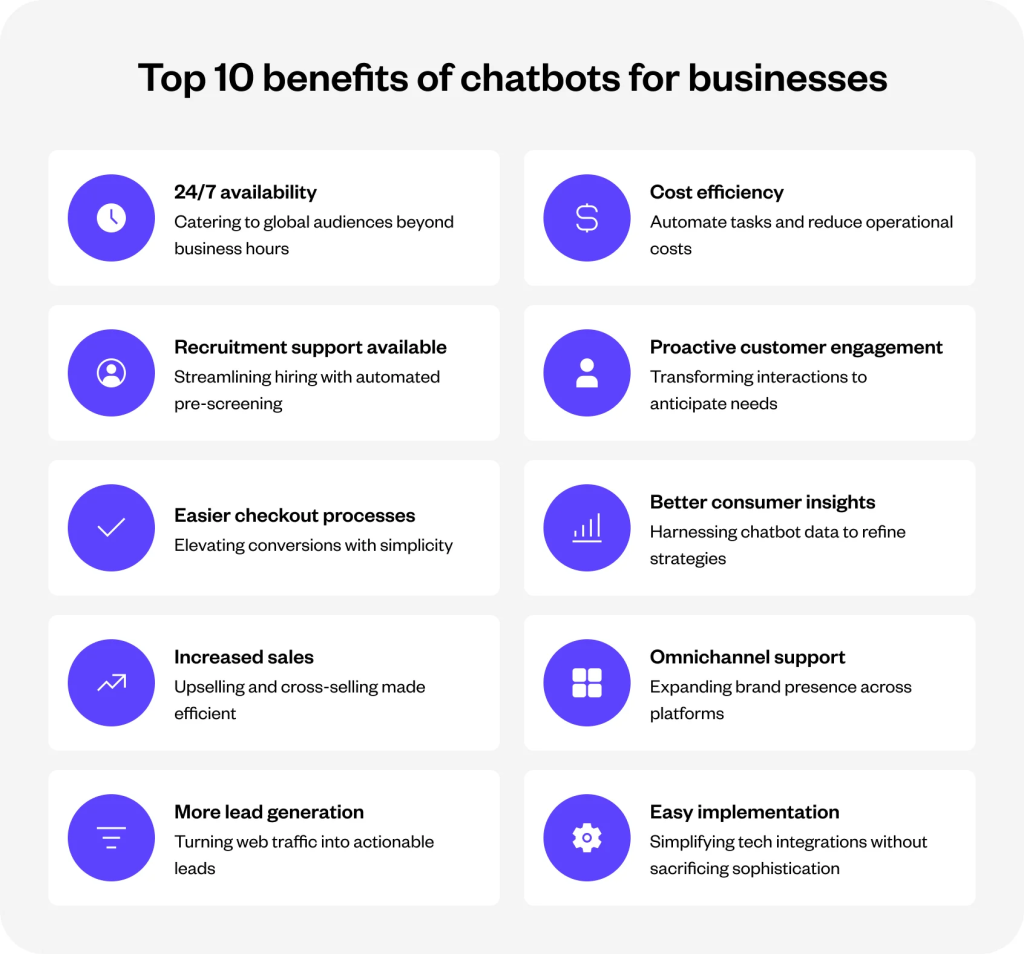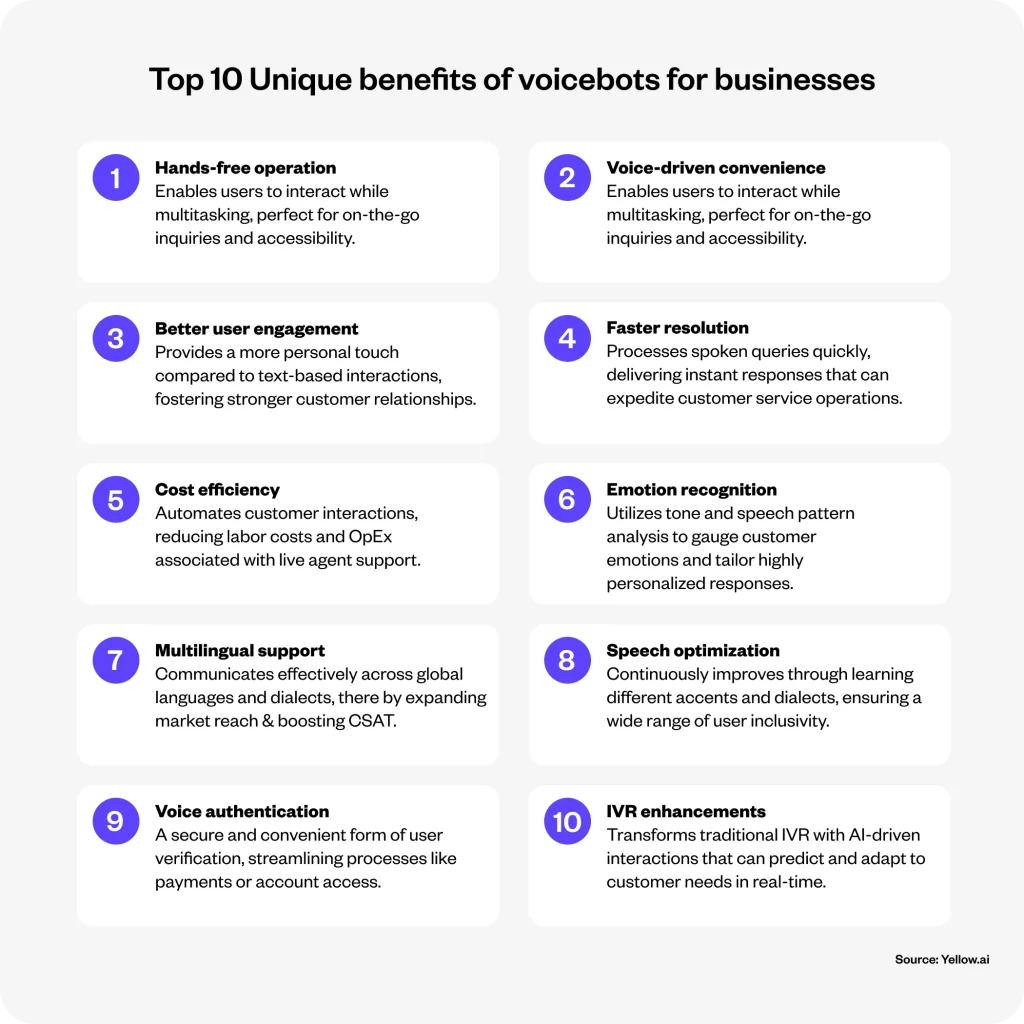As leaders navigating the AI landscape, have you ever wondered which technology—chatbots or voice bots—will best propel your business forward? As digital interactions become increasingly central to business success, understanding the distinct capabilities and advantages of each AI technology is crucial. Both chatbots and voice bots can provide substantial benefits, and can be powerful tools when implemented correctly. Integrating either or both can positively influence your business’s productivity and efficiency.
So, the question remains: which should you choose, or should you choose at all?
This blog explores the key distinctions and applications of chatbots vs voice bots, helping you decide which technology best suits your business needs. From their operational mechanisms to their impact on user experience, we delve into everything you need to know about chatbot vs voice bot. Join us as we navigate this essential comparison to help you make informed decisions in leveraging AI for optimal results.
Related must-reads:
- AI Voice Bot – The complete guide to voice chat
- What are voice bots and their use-cases for different industries?
- Voice AI – What is it and benefits of voice AI for business
- How voice bots are transforming customer service in 2024?
- Voice bot in banking: Transforming customer interactions in 2024
Understanding chatbots and voice bots
Chatbots
Chatbots are AI-powered software applications designed to simulate human conversation through text-based interactions. They use natural language processing (NLP), machine learning, and conversational design to create a smooth conversational flow with customers, answering questions more naturally. Typically integrated into websites, mobile apps, and messaging platforms, chatbots assist users with various tasks by understanding and responding to user queries accurately and efficiently.
Voice bots
Voice bots are AI-driven virtual assistants that interact with users through spoken language. Voice bots comprehend spoken commands and provide audible responses using technologies such as automatic speech recognition (ASR), natural language understanding (NLU), and speech synthesis. These AI-based voice assistants process human speech through a speech-to-text algorithm, converting audio into text and vice versa in a few steps. Voice bots offer a hands-free, conversational experience, ideal for applications where users prefer or need voice interaction over text-based communication.
Key differences between chatbots and voice bots
| Aspect | Chatbots | Voice bots |
| Interaction Mode | Text-based communication, requires users to type and read responses. | Voice-based communication, allows users to speak and listen to responses. |
| Use Cases and Applications | Common use cases include customer service, answering FAQs, providing product recommendations, and order processing. | Common use cases include hands-free operations, interactive voice response (IVR) systems, making reservations, and providing real-time information. |
| Technology and Infrastructure | Utilize AI and NLP technologies to understand and respond to text-based queries. Hardware and software requirements are moderate, often integrated into websites and messaging platforms. | Utilize AI, ASR, NLU, and speech synthesis technologies to comprehend and respond to spoken commands. Requires more advanced hardware and software, often integrated into smart speakers, mobile assistants, and telephony systems. |
| User Experience | Users engage by typing queries and reading text responses. Pros: Quick responses and easy integration into existing platforms. Cons: Requires screen access and may feel less personal. | Users engage through speaking and listening. Pros: Hands-free interaction, accessible for visually impaired users, offers a more conversational and natural experience. Cons: Slower response time due to speech processing. |
| Personalization | High level of personalization by integrating user data and preferences into the interactions. Chatbots can remember previous interactions and tailor responses accordingly. | Similarly high personalization through contextual understanding and integration of user data. Voice bots can offer personalized recommendations and reminders based on past interactions and spoken preferences. |
Benefits of chatbots

Every tool, strategy, or tech addition in the corporate world is akin to a chess move – it needs to be precise, forward-thinking, and value-driven. AI Chatbots in this digital chessboard are your knights – versatile, impactful, and strategic.
Cost-effectiveness and ease of implementation
Chatbots drastically reduce operational costs by automating routine interactions and queries, allowing resources to be reallocated towards more complex tasks. The ease of integrating chatbots into existing systems—with minimal technical skills—further diminishes initial outlay and accelerates deployment.
24/7 availability and scalability
One of the most significant benefits of chatbots is their ability to operate 24/7. This ensures that customers receive immediate assistance regardless of time zones or business hours, significantly improving customer satisfaction. Additionally, chatbots can handle multiple interactions simultaneously, making them highly scalable. This scalability allows businesses to manage increasing customer inquiries without proportionally increasing customer service staff, thereby reducing operational costs.
Versatility in text-based customer interactions
Chatbots excel in managing a wide range of text-based customer interactions across a range of text-based channels. They can answer frequently asked questions, provide product recommendations, assist with order processing, and offer support for troubleshooting issues. Their ability to engage in natural language conversations makes them versatile tools for enhancing customer engagement and streamlining communication. This versatility improves customer experience and frees up human agents to handle more complex queries, leading to more efficient overall operations.
Enhanced self-service
Chatbots empower customers to resolve issues independently without waiting for live agents, which speeds up resolution times and frees up agents for more complex tasks. This self-service capability improves overall service efficiency and customer satisfaction.
Case study
Benefits of voice bots

Voicebots benefit business operations in many ways. Read on to learn about the key advantages of investing in voice automation:
Natural and intuitive conversational experience
Voice bots offer a more natural and intuitive user experience by allowing customers to interact using spoken language. This mode of communication mimics human conversation, making interactions feel more personal and engaging. Users can speak naturally without needing to type or navigate through menus, which enhances overall satisfaction and ease of use.
Hands-free convenience
One of the standout benefits of voice bots is their hands-free convenience. Users can interact with voice bots while performing other tasks, such as driving, cooking, or exercising. This hands-free capability is particularly valuable when typing is inconvenient or unsafe. It allows users to multitask, making their interactions with the bot more seamless and efficient.
Real-time responses and accessibility
Voice bots provide real-time responses to user queries, ensuring immediate assistance. This real-time capability is crucial in scenarios where quick answers are needed, such as checking flight statuses, navigating routes, or getting urgent support. Additionally, voice bots are highly accessible, especially for individuals with visual impairments or who prefer verbal communication over text. By catering to a broader range of users and needs, voice bots enhance accessibility and inclusivity in customer service, making it easier for everyone to access information and assistance when needed.
Instant self-service in preferred languages and dialects
Voice bots excel in offering self-service options by supporting a wide range of languages and dialects. This capability ensures that all users, regardless of their language preference, can interact effortlessly and receive support that feels familiar and accessible. By catering to a diverse customer base, voice bots enhance the inclusivity and reach of your customer service, ensuring that every customer can navigate solutions independently and effectively.
Challenges and considerations
Chatbots:
While traditional chatbots handle routine queries effectively, they may not be advanced enough to handle complex or nuanced interactions, leading to less accurate responses. This is why selecting the right chatbot platform is crucial. With industry leading platforms like Yellow.ai, you get superior AI capabilities that allow the chatbots to be incredibly human-like and ensure highly contextual and relevant resolutions faster across a range of text channels.
Voice Bots:
Traditional voice bots may struggle with voice recognition in noisy environments or with diverse accents, leading to potential inaccuracies and customer dissatisfaction. Also many of them sound very robotic and are quite slow in understanding and processing human speech and then forming responses. This is why selecting the right voice bots can completely change your customer’s experiences. Yellow.ai sets itself apart by minimizing these common challenges. Yellow.ai’s voice bots are designed for fast responses and smooth conversations, even when interruptions occur in over 135 languages and dialects. This ensures that interactions feel natural and effortless for users. Furthermore, Yellow.ai’s robust security measures protect data privacy during voice interactions, making our solution not only more efficient but also more secure. Opting for Yellow.ai means choosing a voice bot that delivers reliability and advanced functionality beyond the industry standard.
Deciding between chatbots and voice bots: Which makes more sense for your business?
Deciding between chatbots and voice bots hinges on specific business goals and customer engagement strategies. Consider your specific needs and goals to determine which technology best suits your business. Reflect on questions like:
- What type of customer experience do I want to deliver?
- Which platforms do my customers prefer to use?
- In which languages should I offer support?
- How detailed does the information I provide need to be?
Evaluating these factors will help you decide whether chatbots, voice bots, or a combination will deliver the most effective and engaging customer experience. Here’s a breakdown to help navigate the choice:
Business needs and goals
Industry suitability: While chatbots and voice bots can be impactful for almost all sectors which have customer service, some industries might benefit more from one over the other. Chatbots are particularly effective in e-commerce environments where quick, text-based responses are essential. On the other hand, voice bots are more suitable for sectors like healthcare, where the ease and accessibility of voice communication significantly enhance the interaction experience.
Omnichannel strategy: For businesses targeting global markets, integrating both chatbots and voice bots offers a comprehensive solution that addresses diverse customer preferences, boosting engagement across various platforms.
Customer preferences and behavior
User interaction preference: Evaluate whether your target audience prefers typing or speaking. This understanding will guide the appropriate technology deployment.
Contextual application: Voice bots excel in hands-free environments or when immediate, spoken feedback enhances the customer experience, whereas chatbots may perform better in text-heavy or documentation-focused settings.
In conclusion, while selecting between chatbots and voice bots might be driven by specific needs, embracing both may be necessary to provide a holistic, efficient, and satisfying customer experience, especially for brands aiming to scale and adapt to varied customer behaviors and expectations.
Future trends and developments
The future of chatbots and voice bots is set to be shaped by significant advancements in AI, natural language processing (NLP), and voice technologies. As AI evolves, chatbots and voice bots will become more adept at understanding and responding to complex queries, providing more accurate and contextually relevant interactions. Improvements in NLP will enable these bots to handle a more comprehensive array of languages and dialects, making them more accessible to a global audience.
We can expect chatbots to become even more integrated into business operations, providing seamless customer support, handling transactions, and assisting in decision-making processes. They will leverage advanced machine learning algorithms to learn from past interactions, continually improving their performance and personalization capabilities.
Voice bots will also significantly enhance voice recognition accuracy and the naturalness of speech synthesis. These improvements will make voice bots more reliable and user-friendly, allowing for more natural and fluid conversations.
Conclusion: Choosing between chatbot and voice bot
As we propel into the future of digital interaction, the integration of both chatbots and voice bots is becoming inevitable for businesses seeking to lead in their fields. Both chatbots and voice bots offer unique benefits and cater to different aspects of customer communication. Chatbots excel in text-based interactions, providing cost-effective, scalable, and versatile solutions for handling routine inquiries and offering quick responses. On the other hand, voice bots give a natural and intuitive user experience, hands-free convenience, and real-time assistance, making them ideal for scenarios where spoken communication is preferred.
That said, the truth is, In today’s dynamic and demanding market, the question for most leaders is not how to choose between chatbots or voice bots, but choosing the right AI platform that offers the best of both worlds. A comprehensive omnichannel strategy that integrates both technologies can significantly amplify your customer service capabilities.
Yellow.ai’s AI-powered customer service automation platform is a robust and cutting-edge solution that leading brands globally are turning to in order to provide an exceptional, seamless experience tailored to their customer’s unique needs.






















